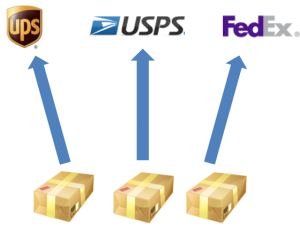 By Ian Hobkirk
By Ian Hobkirk
Managing Director of Commonwealth Supply Chain Advisors
Even for well-established companies that have existing distribution centers, the transition to e-commerce distribution can be painful and frustrating. Companies that feel the growing pains the most keenly are those whose business consists of case picking or pallet picking, with the dominant mode of transportation being Truckload (TL) or Less-than-Truckload (LTL). For these companies, e-commerce is a strange new world where the old ways of doing business no longer apply.
Some of these challenges include:
Piece-Picking – Not Case Picking
E-commerce generally requires a significantly higher level of pick labor per item than retail or wholesale channels. For retail distribution, a worker may pick a carton of six pairs of gloves to be shipped to a retailer’s distribution center.
In the e-commerce world, the same six pairs of gloves may go out the door one at a time. Each item involves a separate trip to the bin location, a separate pick transaction, and a separate trip to bring it back to the shipping area. A six-fold increase in labor is experienced without a commensurate increase in revenue.
Significant Pack Labor
 In the wholesale/retail world, full cases of product are often picked, placed on a pallet, and then loaded on an outbound trailer, with a possible stop at a stretch-wrapping station. Direct-to-consumer commerce usually requires significant additional packing and shipping steps. A few companies are fortunate enough to be able to pick product off the shelf in a ship-ready case, but for most enterprises, the product must be over-packed in a shipping container to protect it from damage and to consolidate multiple line items. This involves erecting a corrugated carton, transferring the goods into the carton, inserting paperwork, adding void-fill material or dunnage, sealing the carton, applying a shipping label, weighing it, and sorting it to the appropriate dock door.
In the wholesale/retail world, full cases of product are often picked, placed on a pallet, and then loaded on an outbound trailer, with a possible stop at a stretch-wrapping station. Direct-to-consumer commerce usually requires significant additional packing and shipping steps. A few companies are fortunate enough to be able to pick product off the shelf in a ship-ready case, but for most enterprises, the product must be over-packed in a shipping container to protect it from damage and to consolidate multiple line items. This involves erecting a corrugated carton, transferring the goods into the carton, inserting paperwork, adding void-fill material or dunnage, sealing the carton, applying a shipping label, weighing it, and sorting it to the appropriate dock door.
Parcel Routing
Pick-Faces Don’t Work
Pick Methods Present New Obstacles
Companies that are used to picking cases to a pallet often try to replicate this basic process when they begin handling e-commerce orders. The result is a messy pallet with totes stacked haphazardly on it, each tote containing a handful of small items. Only a small number of orders can be picked this way before the pallet becomes unwieldy.
With this plethora of challenges associated with e-commerce distribution, it’s no wonder that many companies shy away from filling e-commerce orders. However, countless companies have overcome these obstacles and are managing e-commerce profitably.
Related Reading: Whitepaper: “E-Commerce in the Distribution Center: Making a Graceful Transition.”



